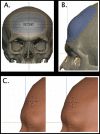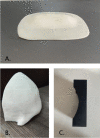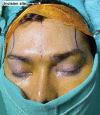Barbie Doll Forehead: CAD Design from Silicon Block
- PMID: 35444761
- PMCID: PMC9015844
- DOI: 10.1055/s-0041-1740524
Barbie Doll Forehead: CAD Design from Silicon Block
Abstract
The forehead is an important determinant of masculine or feminine look of the face. There are many methods described to achieve forehead augmentation for a more feminine face, and they include fillers, autologous fat grafting, silicone implant or methyl methacrylate. We present a case of a "Barbie doll forehead," which is an interesting trend in Asian countries. Availability of silicone implants of various sizes are not uniform and currently unavailable in India. Alternatively, we devised carved silicone block using computer-aided design (CAD). We also discuss the various methods described for forehead augmentation with their advantages and disadvantages.
Keywords: facial feminization; forehead augmentation; silicone implants.
Association of Plastic Surgeons of India. This is an open access article published by Thieme under the terms of the Creative Commons Attribution-NonDerivative-NonCommercial License, permitting copying and reproduction so long as the original work is given appropriate credit. Contents may not be used for commercial purposes, or adapted, remixed, transformed or built upon. ( https://creativecommons.org/licenses/by-nc-nd/4.0/ ).
Conflict of interest statement
Conflict of Interest None declared.
Figures





Similar articles
-
Forehead augmentation with a methyl methacrylate onlay implant using an injection-molding technique.Arch Plast Surg. 2013 Sep;40(5):597-602. doi: 10.5999/aps.2013.40.5.597. Epub 2013 Sep 13. Arch Plast Surg. 2013. PMID: 24086816 Free PMC article.
-
Frontal augmentation as an adjunct to orthognathic or facial contouring surgery.Maxillofac Plast Reconstr Surg. 2016 Oct 5;38(1):37. doi: 10.1186/s40902-016-0084-y. eCollection 2016 Dec. Maxillofac Plast Reconstr Surg. 2016. PMID: 27774440 Free PMC article.
-
Forehead Contouring.Facial Plast Surg Clin North Am. 2023 Aug;31(3):363-370. doi: 10.1016/j.fsc.2023.03.003. Epub 2023 May 12. Facial Plast Surg Clin North Am. 2023. PMID: 37348978 Review.
-
Forehead augmentation with alloplastic implants.Facial Plast Surg Clin North Am. 2010 Feb;18(1):71-7. doi: 10.1016/j.fsc.2009.11.006. Facial Plast Surg Clin North Am. 2010. PMID: 20206091 Review.
-
Integrated Forehead and Temporal Augmentation Using 3D Printing-Assisted Methyl Methacrylate Implants.Aesthet Surg J. 2018 Oct 15;38(11):1157-1168. doi: 10.1093/asj/sjy075. Aesthet Surg J. 2018. PMID: 29596570
Cited by
-
Endoscopic-Assisted Forehead Augmentation with Polyetheretherketone (PEEK) Patient-Specific Implant (PSI) for Aesthetic Considerations.Aesthetic Plast Surg. 2024 May;48(10):1889-1898. doi: 10.1007/s00266-024-03899-1. Epub 2024 Feb 26. Aesthetic Plast Surg. 2024. PMID: 38409347
References
-
- Altman K. Facial feminization surgery: current state of the art. Int J Oral Maxillofac Surg. 2012;41(08):885–894. - PubMed
-
- Hirohi T, Nagai K, Ng D, Harii K. Integrated forehead and temporal augmentation using 3D printing-assisted methyl methacrylate implants. Aesthet Surg J. 2018;38(11):1157–1168. - PubMed
-
- Li X, Kubiak C A, Yang X, Kemp S WP, Cederna P S, Ma J. Forehead fat grafting: Asian facial contouring and augmentation. Plast Reconstr Surg. 2019;144(05):1057–1065. - PubMed
-
- Bass L S. Injectable filler techniques for facial rejuvenation, volumization, and augmentation. Facial Plast Surg Clin North Am. 2015;23(04):479–488. - PubMed
-
- Chao J W, Lee J C, Chang M M, Kwan E. Alloplastic augmentation of the Asian face: a review of 215 patients. Aesthet Surg J. 2016;36(08):861–868. - PubMed
Publication types
LinkOut - more resources
Full Text Sources
Miscellaneous

